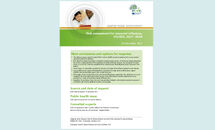Risk assessment for seasonal influenza, EU/EEA, 2017–2018
Since the 2009 influenza pandemic, ECDC has regularly produced early-season risk assessments for EU/EEA countries to inform national public health authorities of key features during the ongoing season. The main objectives of the early season risk assessment are to provide an early description of the epidemiological pattern of seasonal influenza in the first affected countries; to anticipate the progression of influenza activity and to assess the risk of reduced vaccine effectiveness and susceptibility to neuraminidase inhibitors.
Executive summary
First detections indicated circulation of A(H3N2) and B/Yamagata viruses. As the former subtype dominated last season, a high proportion of the population should be protected. However, the emergence of variant strains cannot be excluded and this would increase the likelihood of severe outcomes in the elderly.
Download

See all ECDC risk assessments on influenza
More about seasonal influenza
Disease page
Seasonal influenza
Seasonal influenza is a preventable infectious disease with mostly respiratory symptoms. It is caused by influenza virus and is easily transmitted, predominantly via the droplet and contact routes and by indirect spread from respiratory secretions on hands etc.
Factsheet about seasonal influenza
Influenza is a contagious respiratory illness caused by influenza viruses that infect the nose, throat, and sometimes the lungs. It can cause mild to severe illness, and at times can lead to death. The best way to prevent flu is by getting a flu vaccine each year.
Surveillance for seasonal influenza
Latest surveillance reports and disease data on seasonal influenza; Flu News Europe, Influenza virus characterisation reports, ECDC Surveillance Atlas, Annual Epidemiological Reports.
Prevention and control of seasonal influenza
Seasonal influenza is a vaccine-preventable disease that each year infects approximately 10 to 30 % of Europe's population, and causes hundreds of thousands of hospitalisations across Europe. Vaccination is the most effective form of influenza prevention. Apart from vaccination and antiviral treatment the public health management includes personal protective measures.




